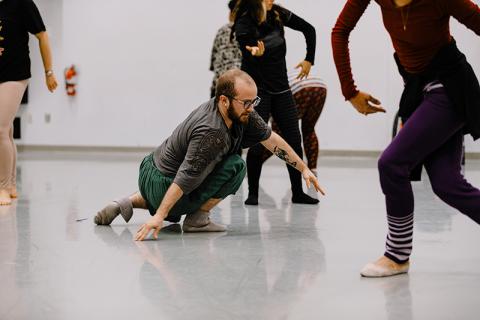Making Space for Different Bodies: Toby MacNutt on Dance and Disability

Toby MacNutt invited workshop attendees to participate in a floor exercise.
Image by Adam Ridhwan
For Toby MacNutt, a queer, nonbinary trans, and disabled dancer and choreographer, adapting is a constant part of their work, whether teaching or learning. In their career as a performer and teacher, MacNutt often has to adjust dance steps or movements to fit their body's ability and form. In a recent workshop sponsored by the Center for Diversity, Equity, and Inclusion, MacNutt talked with a small group of faculty, staff, and students about strategies for adaptive movement and teaching. "Adapting is not just the physical translation of movement," MacNutt said, before explaining that adaptation also has mental, emotional, and interpersonal components.
MacNutt explained that they focus on the thought processes that inform dance movements, rather than the specific form or look of a certain step. They also said that learning choreography meant “seeing what is shown and translating it into your body.” Dancers and choreographers do this all the time, MacNutt pointed out, but the act of translation is much more visible with dancers of different abilities.
“Our body is where we live...We can't assume that we'll extract the person from our bodies and go do a rehearsal with what's left.”
—Toby MacNutt
MacNutt led participants in a floor exercise in one of the Boston Conservatory at Berklee studios. They invited the group to begin in a sitting or lying position, and move around (or up from) the floor in ways that felt organic and interesting to each participant's body. Afterward, MacNutt explained how floor exercise can be inclusive of various body types and abilities. They asked several Conservatory dance faculty to demonstrate other types of movement, such as a leap and a shuffle step. “What do we notice about the movement?” MacNutt asked the participants after each demonstration. “What is the goal of the movement?”
While MacNutt’s work is informed by disability and sometimes by pain, their goal is to encourage dancers to inhabit their bodies fully and freely. “Our body is where we live,” MacNutt told the group. “Our whole life is in here. We can’t assume that we’ll extract the person from our bodies and go do a rehearsal with what's left."




